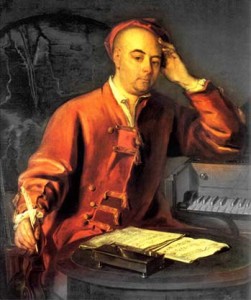
Multiple ‘Messiah’ Performances Mark the Season
I wonder whether anyone does an annual Handel Count at this time of year, tallying up the performances of Messiah that suddenly appear across the land like the red and green foil that magically appears in bags of Hershey’s Kisses.
George Frideric Handel wrote his oratorio in August and September 1741 for a hospital benefit the following spring in Dublin, Ireland (at which male patrons were famously asked not to bring swords, and females asked not to wear hoops in their dresses, so that more people could fit into the hall). And it’s an Easter piece.
But we know it best for its so-called “Christmas portion,” those arias and choruses from the three-part work that fit the season best. In practice, that’s most of Part I, the Hallelujah chorus from Part II, a couple of arias from Part III and the concluding chorus.
Every church and community choir with an ounce of ambition gives Messiah a try at one holiday season or another, and even though its difficulties sometimes overwhelm amateur singers (rarely do we hear the conclusion of Part I, “His yoke is easy,” for just that reason), it never fails to make a big impression. The much-watched video of the Philadelphia Macy’s Random Act of Culture, with its performance of Hallelujah, makes that point eloquently.
At Florida International University on Friday night, the school’s orchestra and chorus offers a holiday benefit concert that features Messiah along with other holiday pieces, and next weekend, the Seraphic Fire concert choir performs its version of the oratorio in concerts at the Arsht Center (Dec. 18) and All Saints Episcopal Church in Fort Lauderdale (Dec. 19).
That same afternoon in Fort Lauderdale, John Wilson, who led annual Messiah performances at Coral Ridge Presbyterian Church for years, conducts the work for the breakaway New Presbyterian Church at a concert in Pompano Beach. And further north that same day, the Masterworks Chorus of the Palm Beaches does its annual Messiah at the Royal Poinciana Chapel on Palm Beach.
That’s four groups doing a major piece of difficult Anglo-German Baroque music in a span of less than two weeks. And in the case of Masterworks (and with Hallelujah at New Presbyterian), the work has been presented as a singalong for patrons who show up with scores, though the penchant for community Messiah sings seems to have faded in recent years.
Last season, former Florida Philharmonic conductor James Judd led a full performance of the oratorio with the Master Chorale of South Florida and a quartet of fine soloists from the Curtis Institute, a throwback to the annual Messiahs the Philharmonic used to present each Christmas season. It was an emotional experience in some ways at the concert I attended, because here was a reminder of the days when South Florida had its own full regional symphony orchestra and big-city events such as the full Messiah.
But it was also emotional because of the power of this music itself. It’s true that doing the Messiah every year in one sense is simply a continuation of a tradition that dates back to the peak of the Victorian era, though today you could argue that the societal norms that sustained it in late 19th century Britain, Canada and the United States are no longer with us. Messiah, you could argue, has had its run, and there are different things we could do at Christmas time, things that would be easier than a piece of early 18th century music that was written for professional musicians by a master of Baroque opera.
Yet that Hallelujah in the Macy’s (and others viewable on the Web, such as one in a Toronto mall food court), and the four local Messiahs give us not just tradition, not just memory, but music — and music of a particularly durable kind. With Vivaldi’s Four Seasons and the Brandenburg concerti of Bach, Messiah is the most accessible, listener-friendly piece of Baroque music we have, and of the three, it is the only one that can reasonably be done by amateur performers.
So we’re all likely to be standing up like King George II reportedly did during one of the first hearings of Hallelujah, and welcoming the art of Handel for the holiday, for many more years to come. It seems to be an indelible part of the season.
Recent Content
-
Artsarticle ·
-
Artsarticle ·
-
Artsarticle ·

